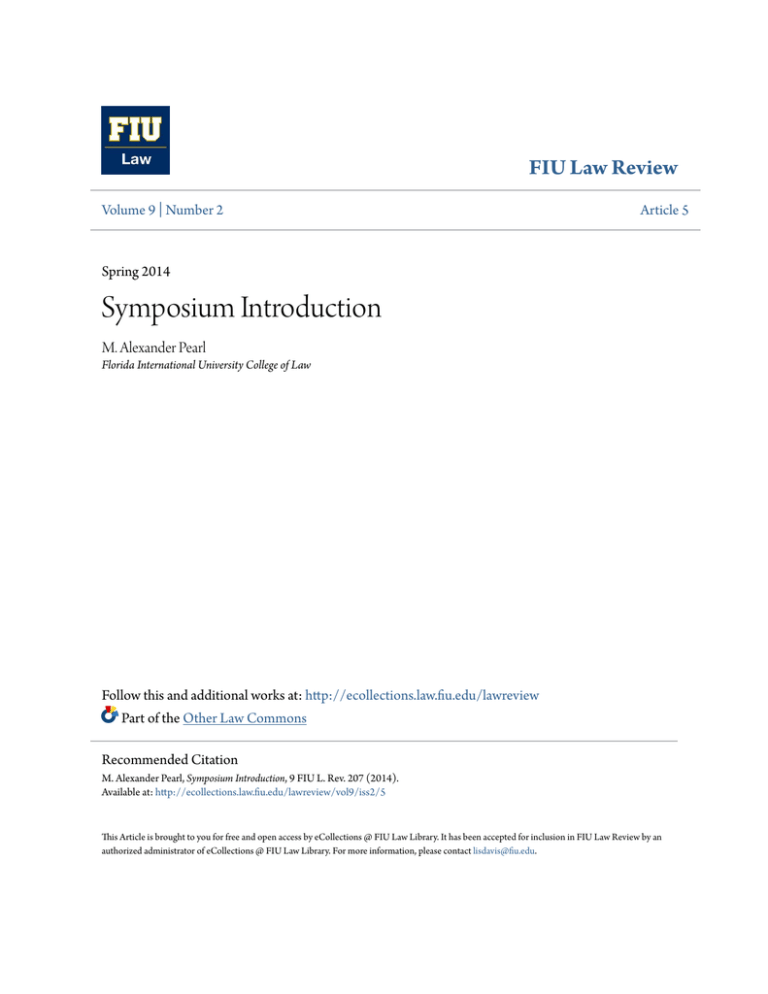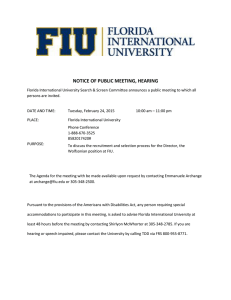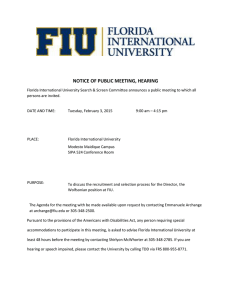Symposium Introduction FIU Law Review M. Alexander Pearl Volume 9
advertisement

FIU Law Review Volume 9 | Number 2 Article 5 Spring 2014 Symposium Introduction M. Alexander Pearl Florida International University College of Law Follow this and additional works at: http://ecollections.law.fiu.edu/lawreview Part of the Other Law Commons Recommended Citation M. Alexander Pearl, Symposium Introduction, 9 FIU L. Rev. 207 (2014). Available at: http://ecollections.law.fiu.edu/lawreview/vol9/iss2/5 This Article is brought to you for free and open access by eCollections @ FIU Law Library. It has been accepted for inclusion in FIU Law Review by an authorized administrator of eCollections @ FIU Law Library. For more information, please contact lisdavis@fiu.edu. PEARL_PUBLISHER (DO NOT DELETE) 10/16/2014 2:22 PM Symposium Introduction M. Alexander Pearl* EDITOR’S NOTE: On behalf of the Law Review, the Executive Editorial Board would like to thank Professor Alexander Pearl for his contribution to this volume of the FIU Law Review and its corresponding symposium. South Florida is a unique place with a variety of distinct communities. It is truly an international region. Our focus in this Symposium centers on a certain type of community often overlooked in South Florida and on the eastern seaboard generally—Indian tribes. Roughly two years ago, I came to South Florida with the experience of growing up in Oklahoma as an enrolled member of the Chickasaw Nation of Oklahoma. Tribal communities are prevalent in Oklahoma, and the history of the state is inherently tied up with the histories of over thirty tribal nations.1 Therefore, it is difficult to live in Oklahoma, without having some cursory understanding of Indian tribes, their histories, and their current status. In South Florida, however, there are only two recognized tribal nations and they compose a much smaller part of the larger history of the State of Florida.2 This results in a lack of awareness and significant misunderstanding of Indian tribes. This is not by any means unique to Florida—Indian tribes are generally not well understood in the United States. My hope is that today is a first step in correcting that. Two key phrases provide important context for what you will be hearing about today. “Indian Country” and “Tribal Sovereignty.” Indian Country is the legal term of art, defined by statute, used to describe a region that is recognized as “Indian” in character.3 Indian Country has a different * Assistant Professor of Law, Florida International University College of Law; J.D., University of California, Berkeley, Boalt Hall School of Law, 2007; Enrolled member of the Chickasaw Nation of Oklahoma. I would like to thank the entire staff of the FIU Law Review for their hard work on this Symposium. In particular, I would like to thank Adam Lewinson, Franco Bacigalupo, Alix Boren, and Daniel Blackman. I am grateful for the support of my remarkable colleagues, Thomas Baker, Matthew Mirow, Howard Wasserman, Tracy Pearl, and Dean Alexander Acosta. 1 Bureau of Indian Affairs, 79 Fed. Reg. 19 (Jan. 29, 2014) available at http://www.bia.gov/cs/groups/public/documents/text/idc006989.pdf. 2 MICCOSUKEE TRIBE OF INDIANS OF FLA. (May 13, 2014), http://www.miccosukeeresort.com/tribe; History, SEMINOLE TRIBE FLA., http://www.semtribe.com/History/TheCouncilOak.aspx (last visited May 13, 2014). 3 See 18 U.S.C. § 1151, which defines “Indian Country” as: (a) all land within the limits of any Indian reservation under the jurisdiction of the United States PEARL_PUBLISHER (DO NOT DELETE) 208 10/16/2014 2:22 PM FIU Law Review [Vol. 9:207 legal status for civil and criminal purposes and limits the jurisdictional and regulatory reach of Federal and State governments.4 All of our panelists here today have at some point in their lives said, “I’m going to Indian Country next week,” or “I have a meeting in Indian Country.” This conveys the idea that they are leaving the United States, or the state they are in, and are going to someplace very different. What makes it different? Certainly, there are significant cultural and linguistic distinctions. In many tribal communities, Native language— Dine, Lakota, or Choctaw—is routinely spoken and witnessing a powwow is an experience unlike any other American cultural phenomenon.5 But these distinctions are not what make Indian Country so different. What makes Indian Country so unique is Tribal Sovereignty. The idea that Indian tribes are sovereign is bound up in the term Indian Country.6 Sovereignty is the concept that Indian tribes are inherently independent political entities, to varying degrees.7 This ability to self-govern is protected under Federal Law and now International Law.8 It is this point that is not well understood by most lawyers and mainstream Americans. Anyone can go to a powwow or hear a Native speaker in their first language and appreciate the value of experiencing a different culture in action. That diversity of culture is something that we understand intuitively and (hopefully) appreciate. However, it is not necessarily intuitive to see Tribes in their proper context—as governments. Government, notwithstanding the issuance of any patent, and, including rights-of-way running through the reservation, (b) all dependent Indian communities within the borders of the United States whether within the original or subsequently acquired territory thereof, and whether within or without the limits of a state, and (c) all Indian allotments, the Indian titles to which have not been extinguished, including rights-of-way running through the same. 4 See, e.g., Nancy Thorington, Civil & Criminal Jurisdiction over Matters Arising in Indian Country: A Roadmap for Improving Interaction Among Tribal, State, & Federal Governments, 31 MCGEORGE L. REV. 973 (2000); Robert T. Anderson, Negotiating Jurisdiction: Retroceding State Authority Over Indian Country Granted by Public Law 280, 87 WASH. L. REV. 915 (2012). 5 Julie Siebens & Tiffany Julian, Native North American Languages Spoken at Home in the United States and Puerto Rico: 2006-2010, U.S. CENSUS BUREAU (Dec. 2011), http://www.census.gov/prod/2011pubs/acsbr10-10.pdf. 6 Johnson v. M’Intosh, 21 U.S. 543, 545 (1823). 7 Worcester v. Georgia, 31 U.S. 515, 561 (1832). 8 United Nations Declaration on the Rights of Indigenous Peoples, art. 4, G.A. Res. 61/295, U.N. Doc. A/61/L.67 (Sept. 13, 2007) (“Indigenous peoples, in exercising their right to self-determination, have the right to autonomy or self-government in matters relating to their internal and local affairs, as well as ways and means for financing their autonomous functions.”); Worcester v. Georgia, 31 U.S. 515, 561 (1832) (“Indian Nations have always been considered as distinct, independent political communities, retaining their original rights, as the undisputed possessors of the soil. . .The very term ‘nation’ so generally applied to them, means ‘a people distinct from others.’”); Santa Clara Pueblo v. Martinez, 436 U.S. 49 (1978) (holding that Federal courts have no jurisdiction to hear tribal membership dispute). PEARL_PUBLISHER (DO NOT DELETE) 2014] 10/16/2014 2:22 PM Symposium Introduction 209 The truth is, Tribes are governments, not completely dissimilar to the State of Florida, or the nation of France. Indian tribes have been governments since long before the founding fathers were around.9 Tribal governments have many of the same struggles that American citizens see in their own three branches. While governmental structures differ significantly among Tribal nations, they remain self-governing communities that have rules and operate thereunder.10 This Symposium seeks to emphasize the history and resurgence of tribal nations in the State of Florida. Understanding the history of this region and of these tribal nations is essential to comprehending the context of present-day tribal communities. The noted scholars presenting and publishing in this Symposium focus on a variety of legal and historical issues. A multidisciplinary approach enhances the narrative and understanding of South Florida tribal communities. The insight from historians is critical in connecting the corresponding legal development with the changes to tribal society over the past century. The Seminole Wars commenced in 1815 and lasted until the late 1850s. This was a significant event for many tribal nations as well as the United States. Some of our scholars focus upon that event and the history associated with it. Professor Andrew Frank examines the development of the meaning of the word “Seminole” within the historical context of the Seminole Wars, Creek War, and the War of 1812.11 Professor Brent Weisman expands the use of the historical lens by considering the tribal communities’ responses to the continued imperialism of the United States.12 Professor Blake Watson maintains this historical focus but shifts to a greater emphasis and analysis on legal doctrine by providing a detailed description of Mitchel v. United States, which applied the seminal Federal Indian Law case, Johnson v. M’Intosh.13 Additional scholars pick up this historical thread and connect it to a variety of present-day legal issues. Legal issues pertaining to water resources are commonplace in Florida, and Professor Allison Dussias focuses on the relationship between the Everglades ecosystem and Florida Indian tribes. She discusses the tribal role in the assertion of legal rights to manage and preserve water resources while sharing responsibilities for the 9 See, e.g., SHARON O’BRIEN, AMERICAN INDIAN TRIBAL GOVERNMENTS (1993). Id. 11 Andrew K. Frank, Creating a Seminole Enemy: Ethnic and Racial Diversity in the Conquest of Florida, 9 FIU L. REV. 277 (2014). 12 Brent R. Weisman, The Background and Continued Historical Importance of the Seminole Wars in Florida, 9 FIU L. REV. 391 (2014). 13 Blake A. Watson, Buying West Florida From the Indians: The Forbes Purchase and Mitchel v. United States, 9 FIU L. REV. 361 (2014). 10 PEARL_PUBLISHER (DO NOT DELETE) 210 10/16/2014 2:22 PM FIU Law Review [Vol. 9:207 protection and management of sensitive ecosystems.14 Professor Matthew Fletcher focuses on the development of Indian gaming and the significant role played by South Florida Indian tribes in advancing that area of law.15 Professor Sarah Krakoff continues her work on tribal membership and identity by discussing the role of history in the development of Seminole and Miccosukee citizenship and sovereignty.16 Mark Reeves provides an in-depth treatment of certain provisions of the Indian Gaming Regulatory Act and how courts have weighed the Tribal-State relationship in the context of Indian gaming.17 In his presentation during the Symposium, Professor Siegfried Wiessner described the present-day dispute concerning the issue of preserving ancient indigenous cultural resources in the context of growing property development in downtown Miami.18 These accomplished scholars provide a multidisciplinary and historically grounded view of tribal sovereignty in South Florida. The hope is that with greater awareness and understanding of tribal governments, sovereignty, and tribal history our pluralistic communities will be more cohesive and better able to work together to solve this century’s next problems. 14 Allison M. Dussias, The Seminole Tribe of Florida and the Everglades Ecosystem: Refuge and Resource, 9 FIU L. REV. 227 (2014). 15 Matthew L.M. Fletcher, The Seminole Tribe and the Origins of Indian Gaming, 9 FIU L. REV. 255 (2014). 16 Sarah Krakoff, Constitutional Concern, Membership, and Race, 9 FIU L. REV. 295 (2014). 17 Mark H. Reeves, A Rejection of State Efforts to Enforce Gaming Laws on Indian Lands in the Absence of a Tribal-State Compact, 9 FIU L. REV. 331 (2014). 18 Dr. Siegfried Wiessner, Professor of Law, St. Thomas University School of Law, Remarks at the Florida International University Law Review Symposium: Miami Circle, the Birthplace of Miami (Feb. 28, 2014).



